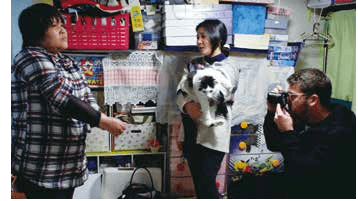Issue:
A group of fixers and journalists have joined forces to ensure that news from disaster-ravaged Tohoku will continue.
Rescue squad
by LUCY BIRMINGHAM
IT WAS A JOURNALIST’S nightmare: Japan’s biggest story of the decade and no fixers or interpreters available. This was a frequent scenario during the March 2011 disaster, testing locally based foreign journalists and many from abroad, desperate to find assistance.
But it’s something that may not happen again. November 2015 saw the launch of the Japan Fixers & Journalists Network (JFJN), now offering a team of seven fixers concentrating on Fukushima and T
ohoku issues. Most double as multilingual interpreters.

Makiko Segawa fixed and interpreted for Dominic Nahr (TIME), here photographing Terumi, who attempted suicide at her temporary home in Iwaki.
JFJN was co-founded by Makiko Segawa and Takaho Murakami, a veteran freelance editor, journalist and fixer for international and domestic news related events. “Fukushima brought us together,” says Segawa, now chief of the network.
Soon after the nuclear accident, Murakami, along with other Japanese freelance journalists, had founded another organization, the Free Press Association of Japan, in response to self censorship by major media outlets. “They wanted the public to get all the information on Fukushima, not just information monopolized by the kisha clubs,” says
Segawa.Segawa joined the Free Press after facing obstacles in her own reporting on the accident. “Besides Shukan Kinyobi or other weekly magazines and tabloids, I couldn’t find any place that would publish the truth about Fukushima.” She later turned to Reporters Without Borders and in 2012 became their Japan correspondent covering issues such as freedom of the press, nuclear related topics and the controversial State Secrecy Law enacted in 2014.
LAST YEAR, SHE AND Murakami decided to organize a group of fixers who could assist foreign journalists leading up to the fifth anniversary of the disaster. It was the start of JFJN. “We brought together many friends working as fixers, including those living in the Fukushima region,” she says. “The official members are posted on the site, but we’ve also got ‘underground’ investigative journalists who we’re collaborating with.” For the 5th year anniversary coverage, the network assisted about 10 foreign journalists from such countries as Singapore, Korea and Australia.
Network members include people like trilingual (Japanese, English Norwegian) 26 year old David Mori. He and his parents live in the town of Iwaki, which lies just outside the initial 40 kilometer evacuation zone set up immediately after the Fukushima Daiichi plant explosions. They chose not to evacuate, despite government warnings.
David also assists with the Christian non profit center set up by his father in 2012 to aid the locals and help revitalize the area. David’s work with the center includes guiding Japanese and overseas visitors. “David also works part time at a convenience store within the 20 kilometer exclusion zone,” says Segawa. “He’s helping out the owner as no one wants to work there because of radiation concerns.”
With his many local contacts, disaster experience and multilingual skills, he has been an ideal fixer for JFJN, she says. “If a journalist needs, for instance, to talk with someone who tried to commit suicide or is struggling with divorce, David has the ability to find that person.”
Other JFJN fixers include Elena Nakai from Kiev, Ukraine. Based in Tokyo, she has extensive experience as an interpreter and translator (English, Japanese, Ukrainian and other Slavic languages) for nuclear conferences and a wide variety of Japanese and international media.
Fixer Yukiko Miyagoshi is a columnist who has written about her experiences in Chernobyl. From the age of 17 she became well known as a Japanese media figure for her visits to the destroyed nuclear plant and her human rights activism. Fluent in Russian, she graduated from the Moscow State University, and now specializes in both Chernobyl and Fukushima issues.
IN 2013, MIYAGOSHI and Segawa visited a hospital in Kiev where they met children of the Chernobyl plant workers, the second generation born after the accident. Many have heart disease and leukemia. “The disaster has been forgotten,” says Segawa, “but the effects of it are still present.”
Segawa and co-founder Murakami fear that Fukushima will face the same decrease in interest as time goes on. “We keep hearing how much the local Tohoku people want the foreign media to continue coming to the region and covering the many stories there,” says Murakami. “The Japanese people don’t trust the Japanese media, especially after 3/11. They know the foreign media has a much bigger impact. Their stories can result in outside pressure that changes things.”
The two are now looking ahead, and readying to organize a strong team of fixers in time for the 2019 Rugby World Cup and the 2020 Tokyo Olympics and Paralympics. They’re hoping that some of the competitions will be held in the tsunami and quake hit areas and help revitalize the Tohoku region.
They’re also looking toward expanding their numbers. “We’re looking for candidates with foreign language ability, translation and interpreting skills, and ideally some journalism experience,” Murakami says.
One of their ongoing challenges, however, is explaining to the Japanese the meaning of “fixer.” “It has a bad connotation meaning someone influencing things behind the scenes,” says Murakami. “Like a kuromaku (black curtain).” They sometimes use the term “news coordinator” to bridge the communication gap.
Segawa and Murakami admit that their fixing work is more about passion than pay. “We’re not in it for the money,” says Segawa. “It’s important and enjoyable work. And it’s so nice that we can help bridge the gap between the Japanese and foreign media.”
Lucy Birmingham is a long-time Tokyo-based journalist, scriptwriter, author and former president of the FCCJ.

